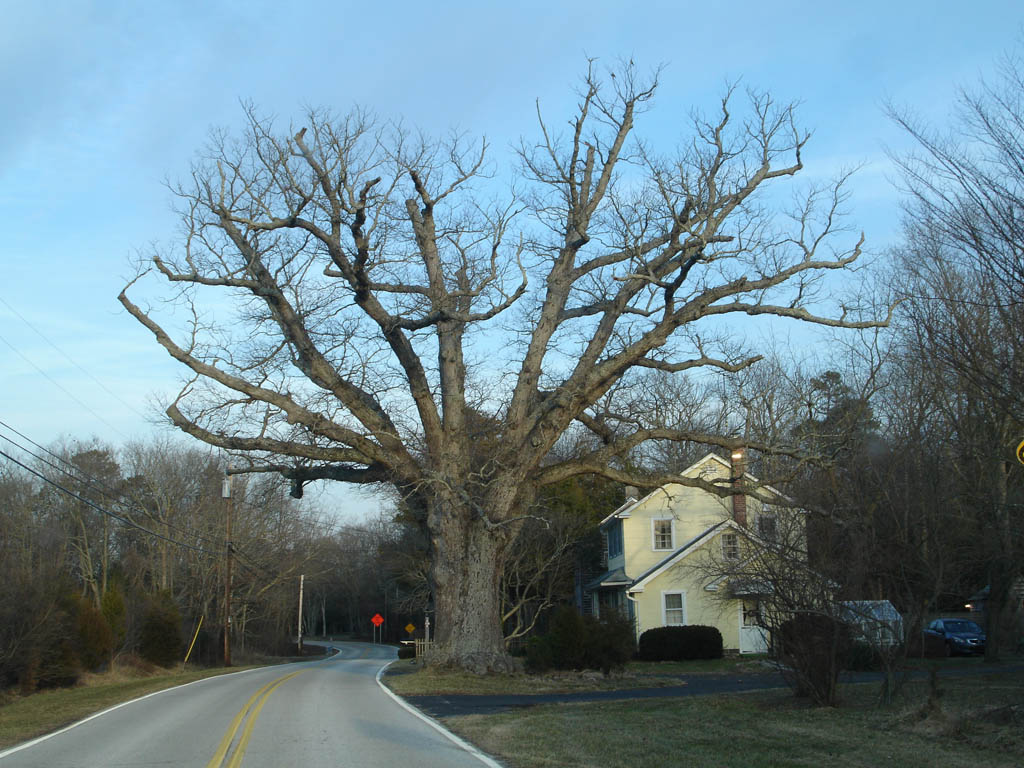|
ENTS,
I went on a safari of sorts today, to re-visit some trees I had seen
back in 2002, now that I have a dgital camera and a measuring tape.
I set out later than I had wanted to because of stopping at my place
of employment first, which it turned out I didn't need to do anyway.
I went down to Cape May County, down in the southern part of our
Pine Barrens. My first stop was a rest stop on the Garden State
Parkway, which is a highway that runs north-south, pretty near the
coast. In this rest stop there is what is supposed to be the oldest
American Holly tree in the state. The bronze plaque in front of it
merely says it's "hundreds of years old". But there is a sign that
says it's "A Part of Cape May County's Tercentennial Celebration, a
Heritage of 300 years". I'm not sure if they are implying that the
tree is 300 years old or not. I know that it does mean that Cape May
County was 300 years old at the time the sign was put up. At any
rate the tree is very old.
The rest stop is not a full service rest area. There are only picnic
tables and bathrooms, which were closed anyway. So I was the only
person there. That was nice. I measured the CBH of it and found it
to be 7' 6". I forgot to write it down, but I'm quite sure that's
what it was.
I read an online article yesterday that mentioned the tree, and
it said in passing that it's a 60 footer. It seems shorter than that
to me, but who knows? It doesn't look like it has lost anything off
its top.
While there I remembered that I would be near Seaville. The front
yard of the Seaville Methodist Church is home to the state champion
Eastern Red Cedar. I don't have our big tree list in front of me, so
I can't remember how big it is. But I visited it, and got some good
pictures of it, along with two other cedars next to the church.
I also brought with me a homemade map that someone drew up on his
computer 6 years ago to show me the location of a Water Oak and a
Bald Cypress along Route 9. I found the Cypress. In fact there were
2 at that location, one much bigger than the other. I did not find
the Water Oak, which was supposed to be the state champion,
according to the person that gave me the map 6 years ago.
I then set out for the Beaver Swamp Wildlife Management Area, to
find a Bald Cypress, the only Cypress known to exist in New Jersey
that was not planted by man. I discussed this tree in a previous
post, and saw it 6 years ago. Today I could not find it. I'm sure
I must have been in the wrong area, though I was probably close. But
what I did find was a pine tree with a CBH of 8' and a 1/2". What a
beauty. The only thing is, I could not definitively identify it. It
looks very much like a Pitch Pine to me, but it may be a Loblolly
Pine, since Loblolly Pines are supposed to be there. In fact I'm
very sure that I did see some there. There were no recently-dropped
cones on the ground under this tree, and I couldn't get a good look
at the cones or needles on the tree, to tell how long they were, or
how many needles were in a bundle. But this tree, whatever the
species, was a great find. I was very impressed with it.
I found a very unusual collection of tree species there, although
I'm sure they are quite normal in that area.
The trees and shrubs I found are:
Spanish Oak (lots of it)
Willow Oak (lots of it)
Black Oak or something similar
Swamp White Oak or something similar
White Oak
American Holly (tons of it)
American Beech (lots of it, though nothing really big)
Eastern Red Cedar
Sour Gum
Sweetgum
Swamp Maple
Sweet Bay Magnolia
Loblolly Pine
Pitch Pine (probably)
Shortleaf Pine (probably)
Hackberry
Norway Spruce (in an old house site)
Mountain Laurel
Highbush Blueberry
There were probably more species, but I either can't remember them
all, or didn't find them all.
I'm quite sure there were Atlantic White Cedar there, somewhere,
though I didn't get close to any. I will have to look at my pond and
swamp pictures closely to see.

Parker's Oak
On my way home I photographed a giant White Oak, a tree with which
I'm very familiar. It is also mentioned in a 1937 booklet called
Noteworthy Trees of New Jersey.
In 1937 the CBH was 15.6 feet, and the age was estimated at 225-275
years. I took the picture through the windshield of my truck.
Sometime several years ago all the vertical leaders were chopped
off. I'm not sure how much was taken off each. So it's kind of funny
looking. I'm hoping that it didn't do any permanent damage. I'm
really hoping.
I will send pictures later. I haven't even sent pictures of most of
the Batsto trees yet, so it may be a while.
Barry
Continued at:
http://groups.google.com/group/entstrees/browse_thread/thread/27940286fcc11988?hl=en
|